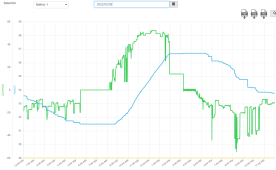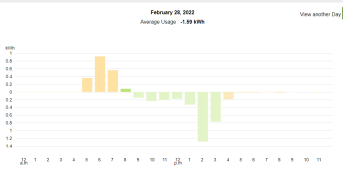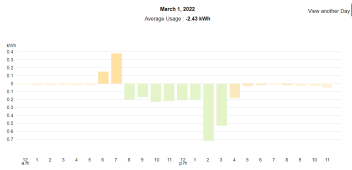Let the pack be low on SOC and ride through to the next clear day? There's a reason you're still grid tied, right?
Also, there's a case where adding more of those nee panels DC coupled would have helped your ability to make it through SCE's peak rates in the evening.
Yes, last night, the pack did drop to about 50% charged (51.5 volts on 14S) at about 9:30 pm, so it made it through the expensive time. Then it just sat in standby while I paid for grid power. If there was a grid outage, I had plenty of battery left to make it to morning, but then this morning is also bad production. I can force i to grid charge a bit if I was worried of a grid outage, like if there was another close by wild fire.
I am really torn on the whole AC vs DC coupling now for the new panels.
WARNING, I over think things all the time. This is my thought process put into words.
DC coupling solves dark start and it's a little more efficient than converting to AC and back. But then there is what happens when the battery is full. With any DC coupled panels, the charge controller will basically just stop taking power from the panel to keep from overcharging the battery. It's not a big deal, but when comparing to the efficiency of charging from Enphase microinverters, I think it more than covers the efficiency difference.
Charging from solar panel to battery with DC coupling 96% efficient. The battery tops out with 1 sun hour left in the day. A 320 watt panel, 1 sun hour is 320 watt hours lost. At 96% efficient, it would lose that same 320 watts in 8,000 watt hours of solar input. 8,000 / 320 watts = 25 hours of charging. So more than 3 days of charging losses are lost in just one sun hour when the charge controller shuts down.
Charging from the 97% efficient Enphase microinverter, and the 95% efficient XW charger section. Total is only 92% efficient. So the loss while charging is double, I will lose that 320 watt hours to efficiency losses in just 4,000 watt hours of sunlight. Only 12.5 sun hours, about two good days here. But what happens when the batteries are full? Let's say the system does take another 0.5 sun hour to complete the charge, so now we still have 0.5 sun hour left in the day. Instead of throwing the power out though, it goes to the house, and out to the grid for credit, if the house is not needing that power. That is 160 watt hours, not being lost.
I know this is convoluted math, but by these calculations, the extra energy to help run the house after the battery is full is more than making up for the efficiency difference. The charging power also will not need an extra 30 minutes from the AC coupling, so the energy recouped is even more.
That leaves the dark start issue. I still think I can make my PLC bring the system back up when there is enough sun to charge the system from the Enphase inverters. I just have to decide if I want to just guess by time, or use a solar cell to measure the sunlight available. And the idea of 1 or 2 DC panels is still floating in my head.
When I first thought about adding the DC charging, I was convinced it was the way to go for the best of both worlds. And I still think there is some merit to that. But now that I have the PLC doing such nice control of the system, many of the DC charging benefits just went away. If I was truly off grid, it would be a different story, 50% DC 50% AC would be a great off grid setup. But with being able to grid export for some credit, my small import/export amounts are nothing, and the grid is my backup when production falls short.
Then the whole Arc Fault thing threw a huge wrench into it. I have now found the Enphase iQ7+ inverters for just $134 each with free shipping. So if I get all 9 of them, that is $1,206 which is now getting down to the same cost as the Schneider MPPT 60/150 charge controller and their RSD/Arc Fault box. Then I still would need 9 of the Tigo RSD units at $30 per panel as well. The cost is a wash. Q cable vs MC4 cables inline fuses, combiner and breakers.
The equipment is certainly cheaper if I went with 6 x 415 watt panels instead of the 9 x 320's, but the free shipping is only on 9 or more panels. The price of the shipping is 2 or 3 microinverters, and the cost per watt on the panels is basically the same. The 3x3 array of 60 cell panels fits very nice on my garage roof, and it is 2,880 watts of panels. The 6 x 415 is a little less at 2,490 watts. The array width ends up almost the same, but the 6 panels is a little shorter in length, hence the slightly less power. Both are 19% efficient panels. Just for my own curiosity, 9 x 60 = 540 solar cells total. And 6 x 72 = 432 cells total. So each cell is making a tick more on the larger panels. I am including Iron Ridge racking rails as well. The 6 panel setup does save a little there as I would only need 4 rails instead of 6, but the rails are actually pretty cheap. The UFO's, End stoppers, all that little stuff adds up.
In the end, I am looking at an all up cost of about $3,600 to add the 2,880 watts of panels. Shipping the cheaper 400 watt panels from San Tan would have been over $400, and those only had a 1 year San Tan warranty. AltE had some nice 425 wat panels, but again, shipping was $600. I am only at $1.25 per watt. That is still very low. By the time I buy the little things locally, it will likely hit $1.50 a watt. One big part of the savings for me is the fact I already have an Enphase iQ system. So I have the combiner and Envoy and outdoor legal disconnect. All things that basically would need to be duplicated if I went DC coupled.
Hope that didn't hurt too much to follow. Now I have all the stuff in two internet shopping carts. That is a $3,600 mouse click. Do I really want to do this? I think I can also put it all on my tax return for the 26% credit next year.






